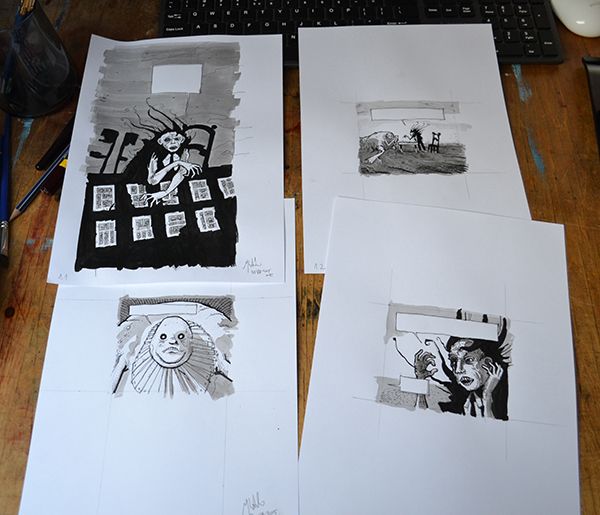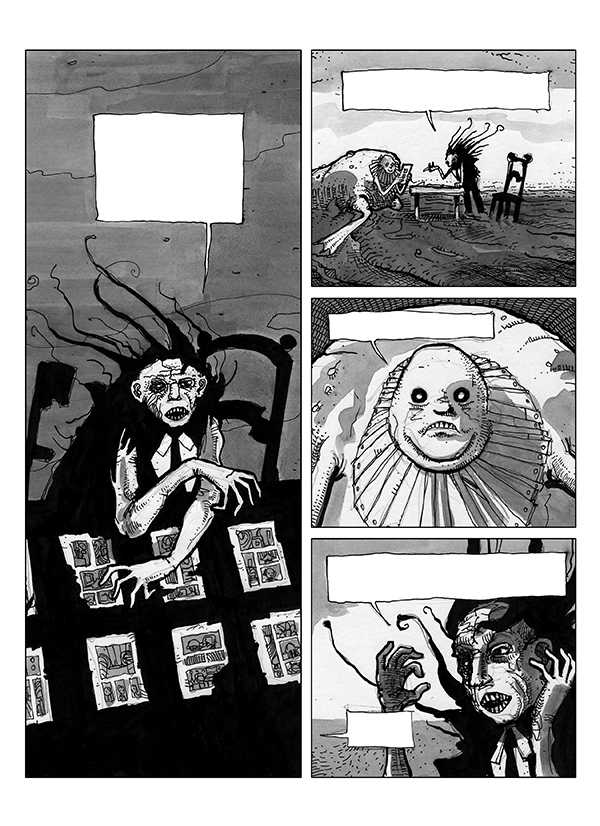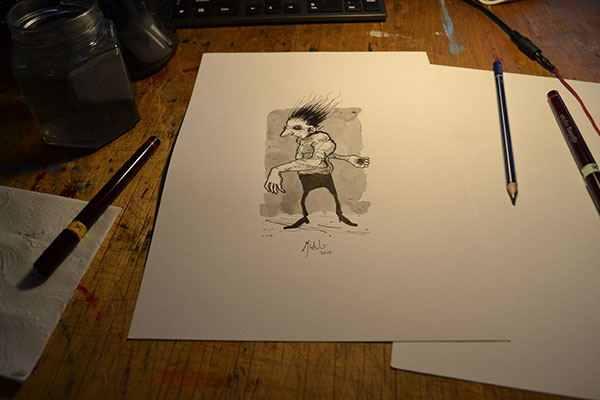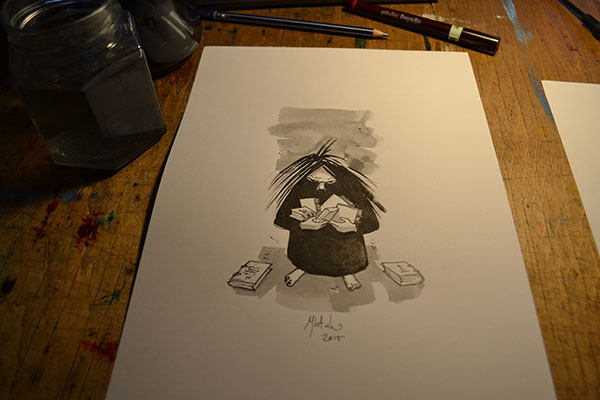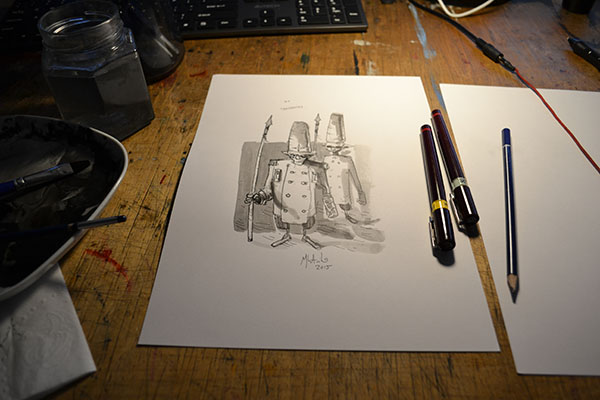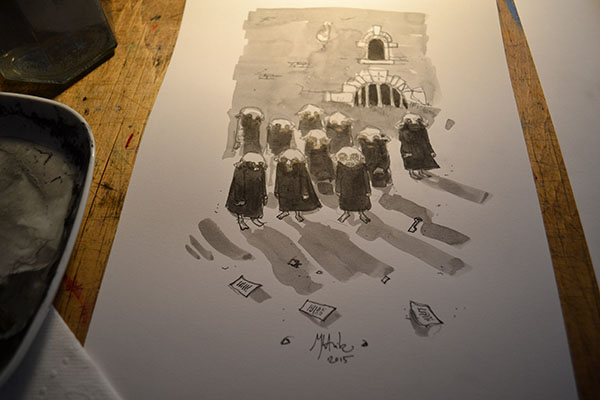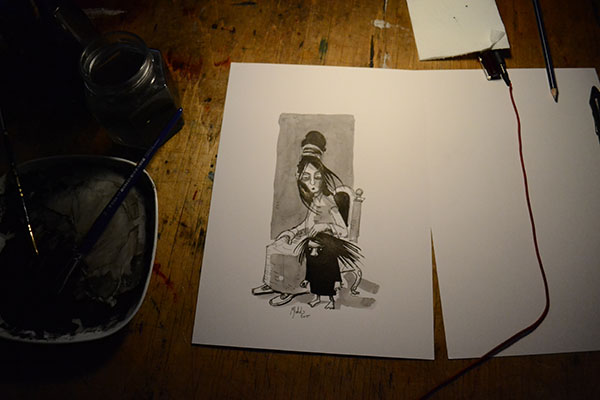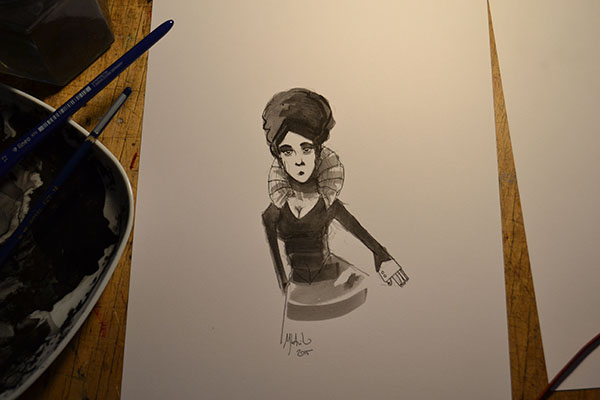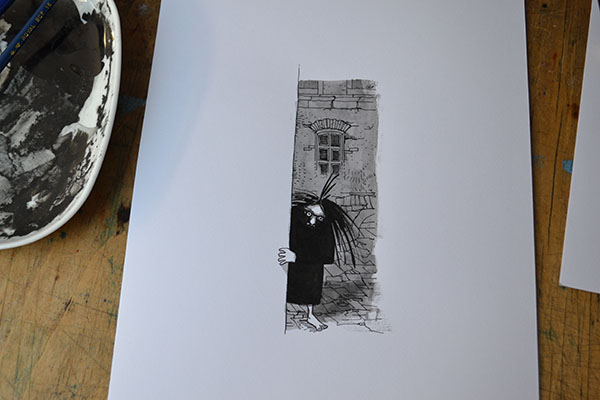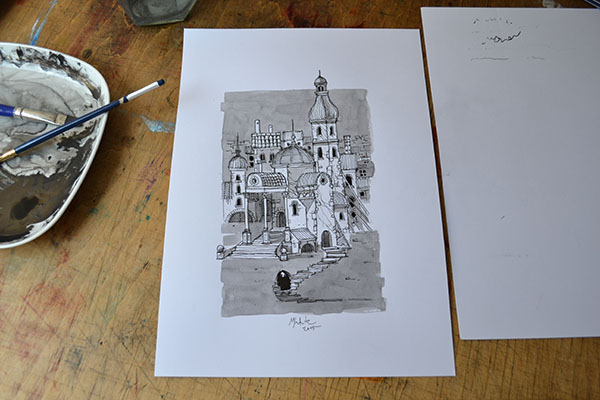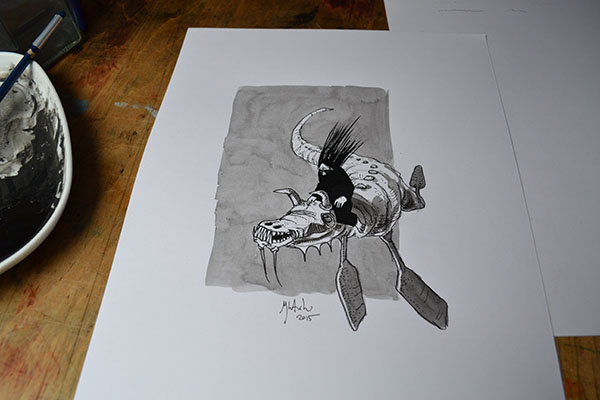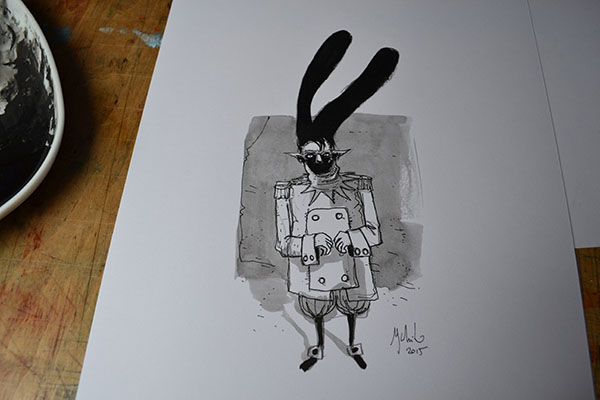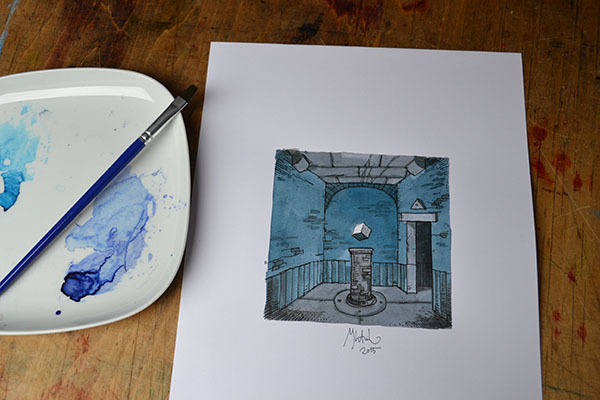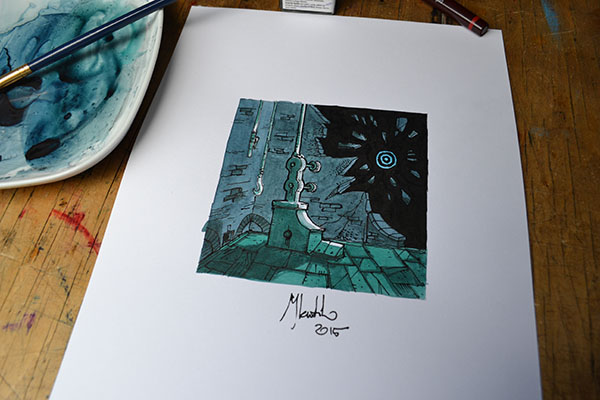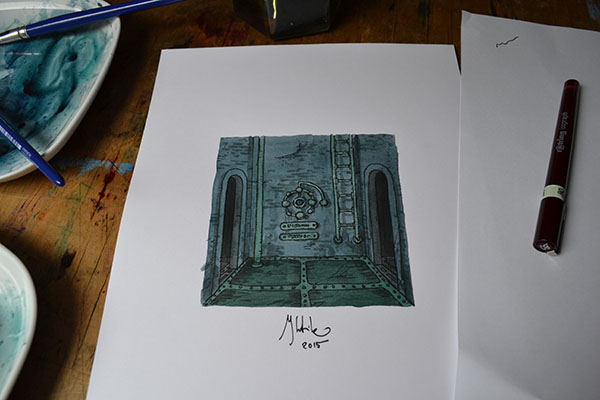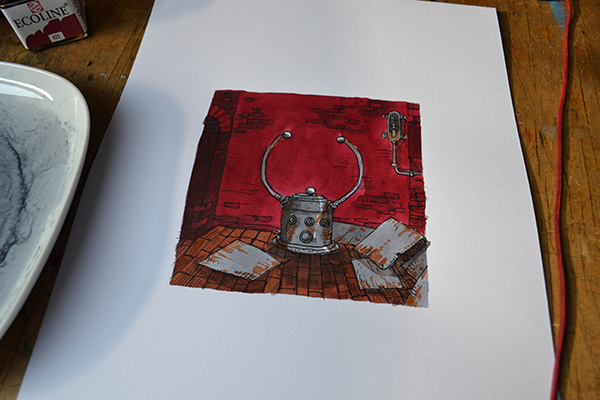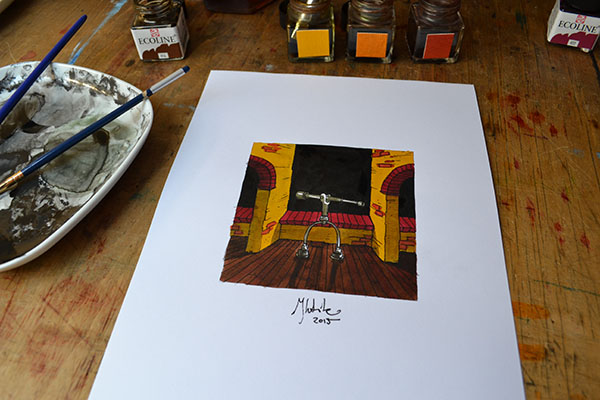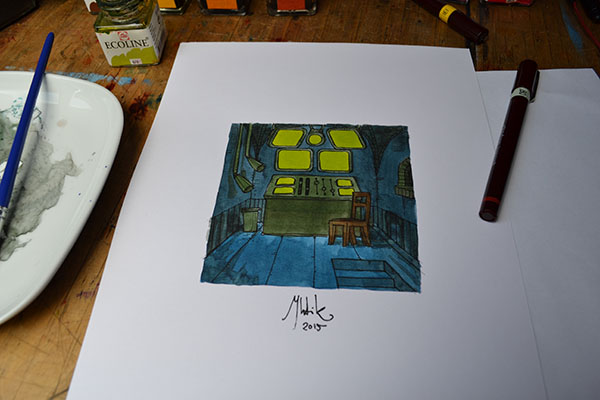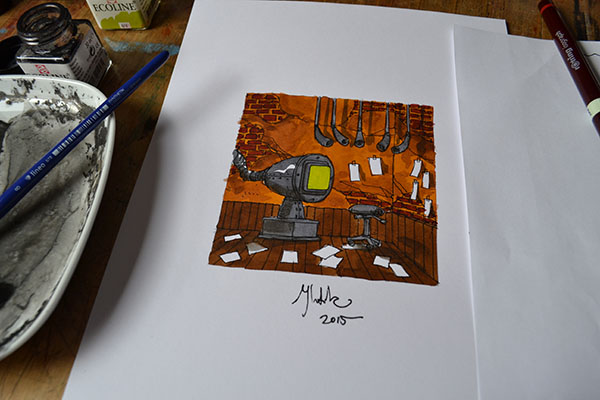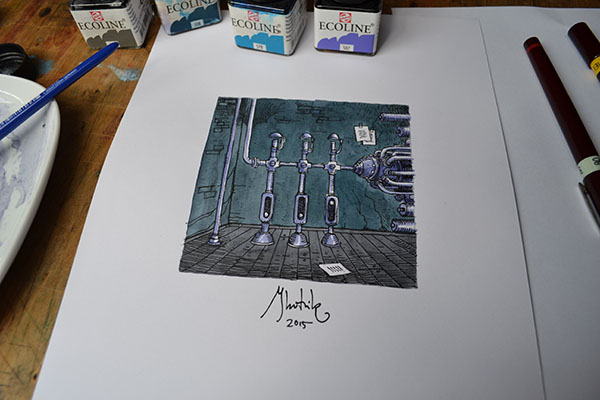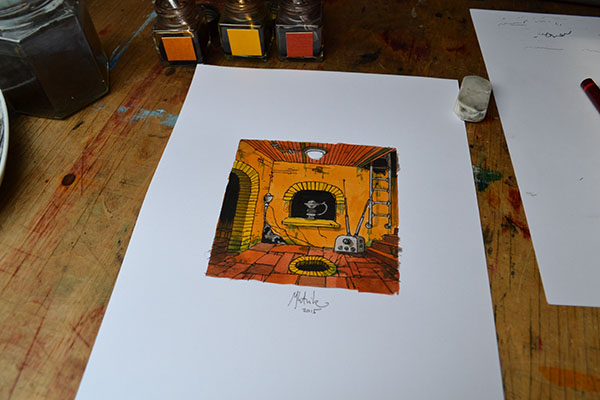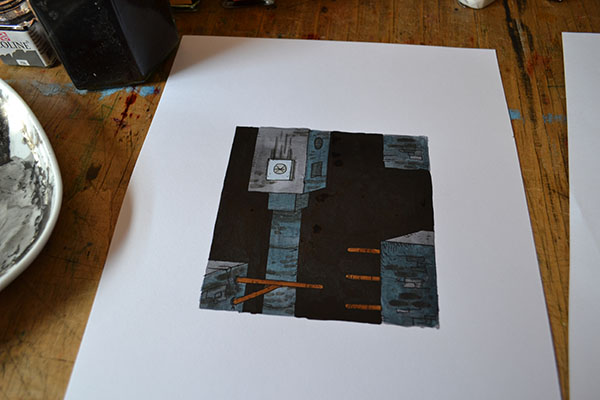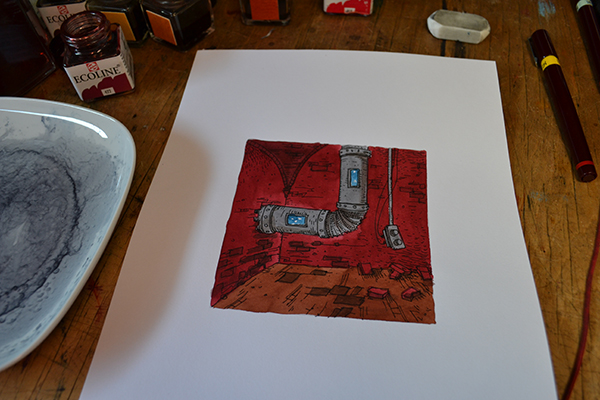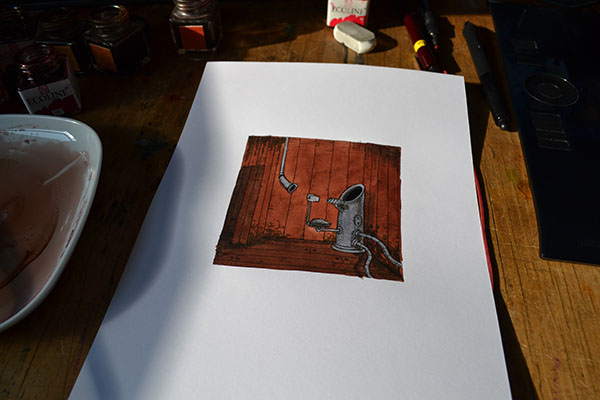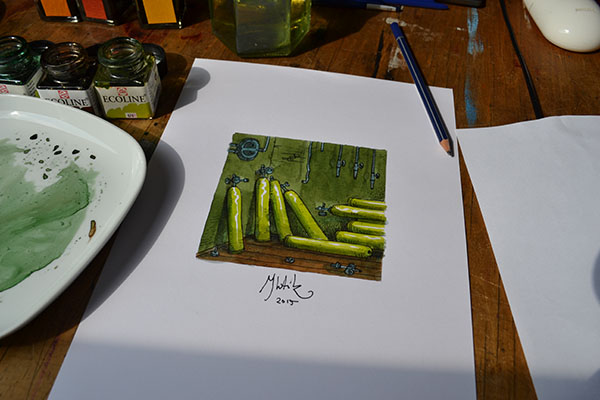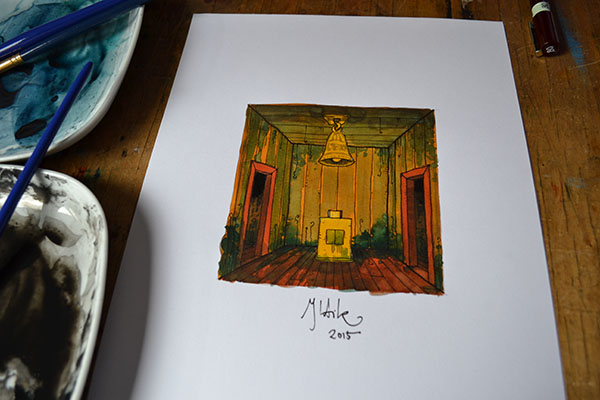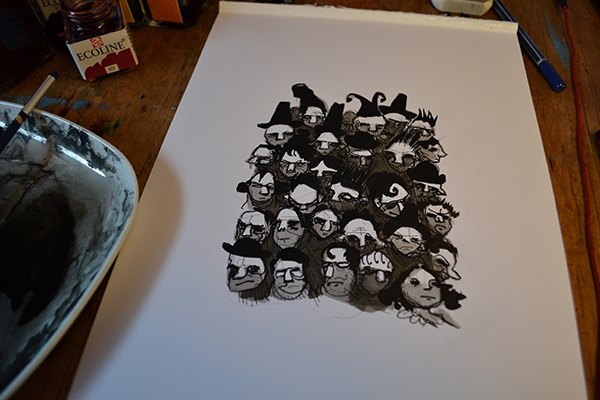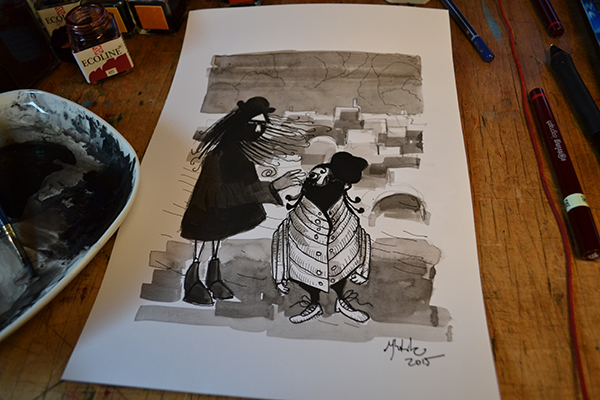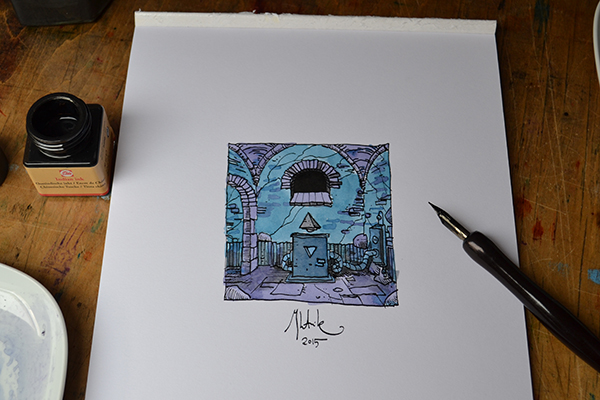10 Gnomes in Montaigut, Liberation review
August 14, 2015
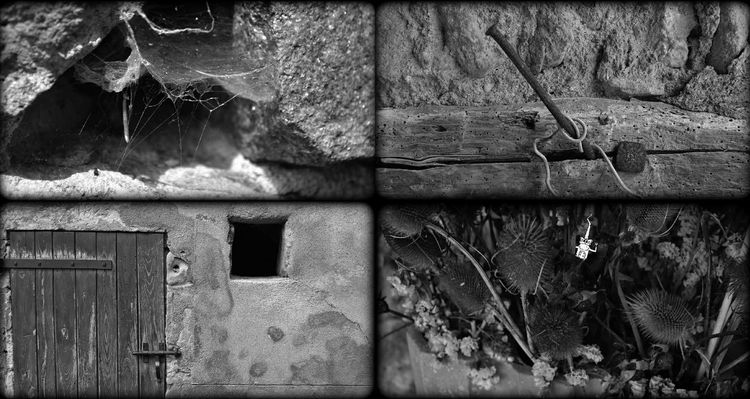
Le grand développeur de jeux polonais Mateusz Skutnik est allé faire un tour à Montaigut-le-Blanc (Puy-de-Dôme) pour les vacances. Il y a vu des ruelles en pente, des tas de bois pour l’hiver, un banc, des chardons, des vieilles portes, des vieilles pierres, et un paquet de toiles d’araignées. Comme il l’avait fait ces dernières années à Venise, Bologne ou Dubrovnik, il a soigneusement photographié en plan d’ensemble et en très gros plan toutes ces petites vieilleries qui donnent son âme au village.
Skutnik a reconstitué une balade virtuelle permettant de cliquer sur certains détails pour les agrandir, et a caché dans les recoins sombres 10 gnomes et un troll. Il s’agit de les retrouver. Prenez votre temps.
Camille Gevaudan.
~~~~
The great polish game developer Mateusz Skutnik came to visit Montaigut-le-Blanc (Puy-de-Dôme) for his holidays. There, he saw little streets, pile of woods for the winter, a bench, some thistles, old doors, old rocks and a bunch of spider webs. As he did it these past few years with Venise, Bologna or Dubrovnik, he carefully photographed in wide shot and close-up of all of these little old things that give the village a soul. Skutnik recreated a virtual stroll that allows us to click on certain details to enlarge them, and hid in the dark corner 10 gnomes and one troll. You’ll have to find them all. Take your time.
Translated by Diane Lemoine.
~~~~
El gran desarrollador de juegos polaco Mateusz Skutnik vino a visitar Montaigut-le-Blanc durante sus vacaciones. Allí vió calles eatrechas, una pila de madera para el invierno, una rama, algunos cardos, antiguas puertas y piedras y un puñado de telarañas. Tal y como hizo otros años en Venecia, Bolonia o en Dubrovnik, fotografió cuidadosamente de lejos y de cerca todos esos pequeños y antiguos detalles que le dan alma al pueblo. Skutnik ha recreado un paseo virtual que nos permite clicar ciertos detalles para ampliarlos y ha escondido en rincones oscuros 10 gnomos y un troll. Tendrás que encontrarlos a todos. Tómate tu tiempo.
Translated by Silvia Rodriguez.
Submachine 10 questions
July 21, 2015
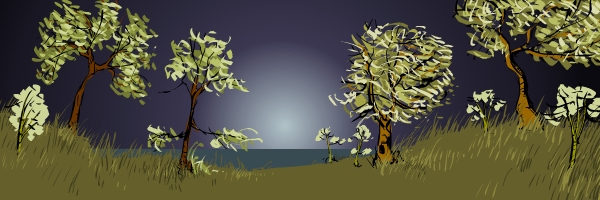
So, guys, here’s the thing.
As you probably know, sometime ago I asked you to send me questions that you think should be addressed in the upcoming Submachine 10. Your response was swift, precise and… uhm… avalanche-like? Not sure if that’s the right expression. Anyway. I’ve collected 112 questions, and as you can imagine, I will not be able to answer them all in the upcoming game. Not even close. Maybe I should just write a book about Submachine. Like a dictionary, or digest.
I’m pretty sure I will cover some of those questions in Submachine 10, however I believe rest of them will have to wait for standalone Submachine games that will come later on. Those, while being stripped from the main storyline, will have plenty of room to discuss all those subjects in question. So, more Submachines, yay.
Here’s the full list of Submachine questions I’m supposed to tackle:
- In Submachine 9, the Player see the graves of Mur and Liz. Are they actually dead?
- Is the Player dead and the Submachine is some sort of purgatory?
- What really is the submachine
- who Mur and Liz really are
- who are all the others that explored the maze of the network of places we have been
- Was it all just a dream, an amazing place existing in the mind of the character we play as, or is this a story of someone traveling to a place we all want to visit, where travel is done by a machine, a portal and such?
- What’s so important in the fifth layer
- why don’t we ever see the main character
- elaborate a bit more on the plan
- How humans discovered the Subnet, the layers
- why Murtaugh (and Liz?) were chosen
- What was Shiva’s intention
- why the structure prevailed after the deaths of Mur and Liz
- Did the Player’s journey have some purpose?
- How did the Player begin all this
- where did he come from
- Who is the player?
- what time period is he living in compared to when Mur and Liz were alive?
- I would like if it gets cleared up if there is time travel involved in the series and in what way.
- why the karmic portals are destroying the subnet,
- what implications this has for the submachines and the player
- further explanantion to the time layer
- how Thoth and Shiva are both involved
- And where is Einstein?
- Clearly even if the player can’t interact with Mur, Liz, or Einstein directly, they’ve interacted with each other directly at some point – how can they have done so but none of the other people in the subnet have encountered each other?
- Where is sunshine_bunnygirl_17
- how much more connection there was with Covert Front.
- if there will be answers about the nature of the Submachine (location.. infinite? growing?…).
- Where are the corpses of people lived in the submahine?
- Is it possible the player was everyone of them in his/her past?
- Who buried the lighthouse and why?
- Did the events that the game discusses happen centuries ago or did the player participate in them?
- Will we ever see an actual human character?
- what happened to all the other, unnamed people who left notes throughout the Submachine?
- Where did they all go?
- Or were they ever really there?
- Why did Mur and Liz die?
- How could we talked with Mur, not so long time before his death?
- Why we didn’t meet anyone in Submachine?
- explain the links between different parts, so that we know if we are travelling in time and/or space/dimensions
- if everything is happening in chronological order.
- how Mur and Elizabeth came from that hostile situation between each other to that marvelous plot twist on sub9.
- In sub6 , where we have to hack the system, did human create/build that place ??
- I’d to know who and why created Wisdom gems and what they really are
- Are we alone?
- Why are we
- Kim był Mur i Elizabeth jak to się stalo, że się poznali, a może razem pracowali nad czymś?
- czy tą grę da się ukończyc?
- czy postać w którą się wcielamy kiedykolwiek wyjdzie z submachine?
- Kto tym wszystkim steruje po smierci Mur?
- Can we just see M’s face?
- Or atleast is arm?
- Einstein, how he is able to transport himself through portals and such, but where did he end off?
- everything what has happened in the subnet is the reality, or the machine was done in order that the persons were living in a virtual reality because in the earth or the reality happened a collapse, for this way saying, the apocalypse?
- How important the light is?
- more about what happens when you create a portal inside a portal
- things about the history of the submachine, at least the history that’s connected to humans somehow, knowing more about how the humans found the subnet (did someone create it and other people found it later on?
- did humans just stumble upon it somehow and decided to add their own creations to it? how did that happen?
- is there something outside the Submachine?
- How Sub_1 fits in with the overall plot since it’s brief story
- I finally want to know what those bells are exactly for!
- Where is Kent? a submachine location or a place on Earth?
- What’s the connection between submachine and Earth/The computer that surpassed human inteligence?
- What’s the connection between the Kent waterfall and karma?
- What is the rough timeline of the events in the series?
- ow do the places we visit in the series fit within the structure of the Submachine, and how are they connected? For example: which layer(s) were we during Sub1-Sub6? Did we travel from the Outer Rim to the Core at the end of Sub1?
- Who is Shiva/the Computer? Are they one and the same?
- Where’s the Loop in respect to the 8 Layers?
- Do Defense Systems and Subbots operate in all the Layers of Reality?
- Does the Plan have anything to do with the cubic shape of each room?
- Are the persons who wrote the notes in latest Submachines the former Basement Exploration Team?
- How did he get to Subverse and Basement from Sub1?
- Did he has some special purpose in Sub1-Sub4 except escape from the trap?
- If Subbots do exist in subverse…Show them and tell about them at least in one note, please?
- What connection do Sub0, SubFLF, SubFLF HD, Sub32 have with main series?
- Who are protagonists of these side games? Their purposes?
- What does “MAP” symbol mean? (Symbol we can see in all submachine games’ main menu)
- Why does ikentt have karma flow/water?
- Where is it located?
- Why there were excursions in Winter Palace, South Garden and Lighthouse?
- Does “our real world” exist at all in Submachine game universe?
- Did we really make time travel in Sub2, or in some other game?
- How is important the time in Submachine universe?
- How many people organizations are there?
- What is the company? (Sub4 Ship note)
- What organization ordered to scientist who called this place as “Submerged Machine” to work with submachine?
- What is Fourth Dynasty?
- What happened with “Temple/Murtaugh/Shiva Cult” (Sub9)?
- What happened with Lab workers? How did they ended there at all?
- From what organization are guys from Sub8?
- Who are guys from Sub9 secret notes?
- Is there God? aka Shiva Or all is just technology? aka Computer (or something like this…)
- explanation what happened in Sub2 intro and Sub2 outro…
- If we/Payer have one-dimensional mind (Sub9 secret note), then why do we can’t meet any people in Submachines? What is the problem?
- Way in the past you talked about the creator of the first Submachine, and how his creation went haywire. I would very much like to get to know how he reacted to it and felt about it all. He seems like such an important, yet underrepresented character.
- What happened to Henry O’Toole when “Murtaugh’s” religion began gaining traction. Was he forgotten or did his works become widely acknowledged.
- How do the people of the Subnet see their history, which eras do they revere and which do they condemn. Related to this, maybe we could finally get the sub-eras if not explained, at least listed.
- Murtaugh is a surname, you’ve admitted as much. What was Murtaugh’s first name?
- Are we alone in Submachine? Is there something there, lurking in the shadows, or are we just the only explorer traversing the subnet?
- Will the Third Layer ever be repaired and brought whole again?
- In Sub_9’s super secret bonus area, it was mentioned that Murtaugh was shown the future by Shiva that left him quite happy before he died. Perhaps this is what he saw? Perhaps we, the Players, will have our hands / cursors on this kind of conclusion?
- Who happened to commission the Submachine network (if it can be called that)?
- Why is there no life, inside the Submachine?
- What was the need for the limited appearance of firearms in Submachine? (Think I remember seeing something akin to a machine gun, in one of the games? Not sure.)
- What is the purpose of the cultural deities in Submachine?
- What happened to the notes we have collected along the way, with the exception of Sub5 notes?
- Who put the golden seals in Murtaugh and Elizabeth’s tombs?
- What is the purpose of the four symbols we see in Sub2? We never used them in the game.
- Where did Murtaugh obtain plans to draw the teleporter in the lighthouse
- Who was the man that left mentioned in Sub7, and why did he leave, did he also have power like Murtaugh’s?
- Why did Murtaugh teleport to the loop? What happened that caused him to enter the loop and not some random location in the outer rim, or is the loop the outer rim?
- sub4 – What on earth is behind the metal plate? (beginning on the roof)
10 Gnomes in Montaigut, recenzja na Esensji
July 16, 2015
„10 Gnomes in Montaigut-le-Blanc” jest bodaj pierwszą grą, którą Mateusz Skutnik zrealizował w wyniku osiągnięcia przyzwoitego (jak dotąd) wyniku swej akcji w serwisie Patreon.com. W dodatku dostępna jest za darmo (zip), w full HD (1920×1080), ukończona dwa miesiące przed początkowym planem.
Montaigut-le-Blanc to niewielka miejscowość w centralnej Francji, w regionie Owernia. Autor gry bawił tam i zdjęcia robił w lipcu zeszłego roku. Dla tych, którzy zachwycą się widokami na zdjęciach, podał również współrzędne geograficzne: 45.58619 / 3.08952.
Gra jest bardzo prosta, bazująca na pięknych, czarno-białych fotografiach ukazujących widok ogólny i coraz bliższe szczegóły pewnej kamienicy. Przejeżdżając kursorem po obrazku, znajdujemy miejsca aktywne (kursor zmienia kształt), w które kliknięcie pozwala na zbliżenie, podejrzenie szczegółów detalu – czasami jest to ujrzenie pod innym kątem, czasem obrót w miejscu, do tego dochodzi oczywiście także powrót do poprzedniej lokacji / poprzedniego kadru. Gdzieś tam, w szczelinach, dziurach, zakamarkach, schowało się tytułowe 10 gnomów… i nie tylko! Białe, brodate postaci nie zawsze są zadowolone z zakłócania ich spokoju – choć zwykle machają radośnie na nasz widok, czasem pogrożą pięścią.
Kliknięcie w krasnala zapala kolejną lampkę u dołu ekranu, przypominając, ile jeszcze przed nami… A czas upływa! Choć tym razem na przejście całości i wykrycie wszystkich brodaczy nie wyznaczono limitu minut, można wstrzymać upływający czas, by mimo potrzeby oderwania się od ekranu uzyskać lepszy wynik. Można także przełączyć się z domyślnego trybu fullscreen na tryb okienkowy i grę pomniejszyć (choć w ten sposób gracz sam sobie utrudnia zadanie), można włączać i wyłączać ambientową muzykę i dźwięki towarzyszące klikaniu. Czy wycieczka po Montaigut-le-Blanc składa się z mniejszej niż zazwyczaj ilości lokacji (z pewnością nie zerknąłem do wszystkich…), czy też zacząłem dochodzić do wprawy w łowach na małe białe stworki – dość powiedzieć, że „10 Gnomes in Montaigut-le-Blanc” jest pierwszą w swym cyklu, którą ukończyłem w przyzwoitym czasie za pierwszym podejściem.
Trzymamy kciuki za dalsze powodzenie akcji w serwisie Patreon.com i czekamy na kolejne obiecane gry.
Autor: Wojciech Gołąbowski
10 Gnomes in Montaigut-le-Blanc
July 15, 2015
play | location video | recenzja na Esensji | Liberation review
Today I want to show you the power of what’s going on. That whole Patreon situation. How it liberates me to basically do my creations just for you, and not entire internet (as I don’t have to scratch and claw for ads anymore). Remember the predicted release date for new 10 Gnomes game? September? Scratch that, I made it already and you can play it right now. Not only I’m giving you this game two months before schedule, it’s in full HD, 1920×1080 and, naturally, free. All thanks to people supporting my art on Patreon.
Thank you again.
Escape from JIG, softpedia review
July 5, 2015
Some of the most ingenious inventions ever were devised by prisoners from around the world, partly because they have so much time on their hands, and partly because they have no other choice than to improvise. Hence, whether it’s alcohol made out of the most unlikely stuff or ingenious tools to help them escape, those who have nowhere else to go can really put their imagination to work.
Try to escape from a strange environment.
Escape from Jay is Games works along the same lines, only it features a fewer shanks and no soothing voice overs from iconic actors. In essence, however, your main goal is to get out of a weird room filled with old arcade machines, strange computers, and what appears to be some kind of alien hooked to a virtual reality headset. To do that, you must gather useful objects and use them in ingenious ways.
The story is quite simple and straightforward, although that may just be due to the fact that you don’t really find out too much about it along the way. A few notes give you a hint about what’s going on, but you are kept in the dark for the majority of the time. To make matters worse, there are so many questions that need answers, especially when you consider the fact that there is an arcade machine playing Pong by itself for the entire duration of the game.
Combine items to unlock the way further.
In order to continue the story, you have to find certain items that can be used in combination with others to achieve something. Hence, whether it’s a key that opens a certain door or a transistor that can restore a computer’s functionality, everything that can be picked up has a purpose. Not only that, but you can also combine other items with each other, or even use some of them multiple times, such as the knife.
Another great thing about the game is the visual aspect, because although the graphics may look simple and in 2D, the artwork is great and you can tell that the artist took his time coming up with it. The strange machinery and the nice choice of colors create a unique atmosphere, although the soundtrack contributes a lot to the feeling as well.
A beautiful adventure game with plenty to offer.
Although the experience is a bit too short, Escape from Jay is Games is certainly a nice concept, and you can have a lot of fun with it. In addition, the puzzles are ingenious enough to keep you guessing for a while.
Author: Alexandru Dulcianu
Daymare Morphs, the new face of Morfolaki series
June 30, 2015
This is what the second life on Morfolaki series will look like. The revival, under the Daymare brand will be aptly named Daymare Morphs, and will start in January 2016.
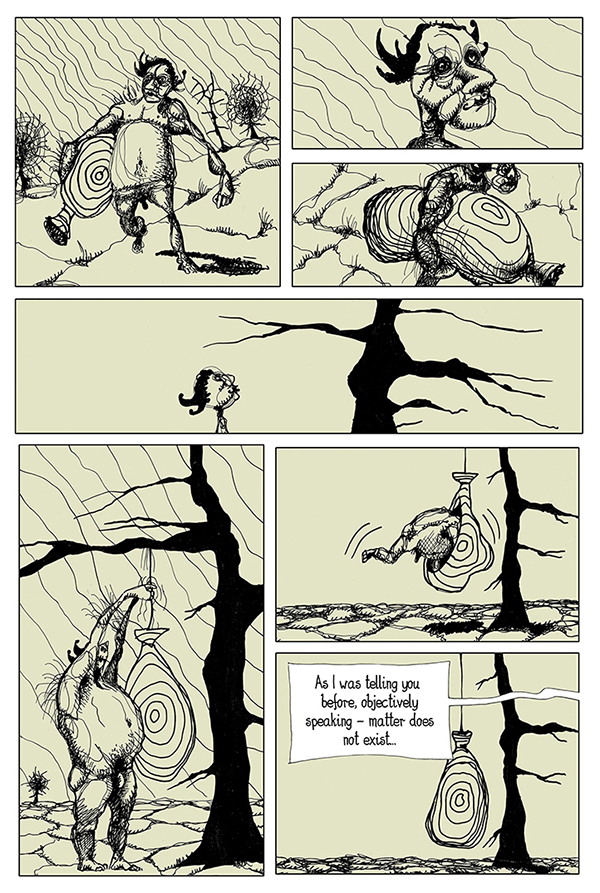
Rewolucje pod Śniegiem; recenzja na WAK-u
June 25, 2015
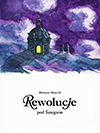 Gdyby był grudzień, napisałbym że zima znów zaskoczyła drogowców. W czerwcu mogę co najwyżej napisać, że zaskoczyła wynalazców, którzy grają główne role w serialu „Rewolucje” kreowanym przez Mateusza Skutnika.
Gdyby był grudzień, napisałbym że zima znów zaskoczyła drogowców. W czerwcu mogę co najwyżej napisać, że zaskoczyła wynalazców, którzy grają główne role w serialu „Rewolucje” kreowanym przez Mateusza Skutnika.
No bo z tym zaskakiwaniem drogowców to standard. Rokrocznie media wszak rozpisują się o nieprzejezdnych drogach, opóźnionych autobusach i pociągach a także miejskich chodnikach, po których nie sposób chodzić. Nieprzejezdne ulice, nieodśnieżone chodniki… To wszystko mamy też w dziewiątym tomie „Rewolucji” z dopiskiem „Pod śniegiem”. A nawet więcej. Bo w najnowszym skutnikowym komiksie jest jak w jednym z wierszy Marcina Świetlickiego. „Śnieg spadnie i zasypie wszystko”…
Aż po czubki dachów. Właściwie jedynie one sterczą znad białego puchu, z którym próbują sobie radzić kolejni wynalazcy zjeżdżający – by myśl techniczna ewoluowała – do namalowanego miasteczka. Jak Von Trompp (z dyplomem zdobytym w Karlsgut w roku 1876), który testował właśnie swój prototyp maszyny do odśnieżania. I wszystko byłoby dobrze, gdyby nagle nie zahaczył o kilka wystających balkonów.
Osadzając “Rewolucje” pod śniegiem Skutnik miał okazję, by pokazać całą masę ciekawych patentów. Pokusił się np. o połączenie ogrzewanego baraku ze śnieżnymi rakami. Na innej z plansz dostajemy szalone ustrojstwo będące zestawieniem czegoś na kształt portowych dźwigów z tarczami ryjącymi przed laty bełchatowskie złoża węgla brunatnego. Do listy wynalazków dołóżmy „perforator ręczny”, „stabilizator materiałów radioaktywnych” oraz kulę szpiegowską jeszcze z czasów wojny. A że w zanadrzu autor skrywa dwóch szaleńców – profesora Everetta specjalizującego się w podróżach w czasie oraz profesora Flombeura mającego do czynienia z teleportacją – ma już wszystko, by stworzyć zakręcony scenariusz. Może też stawiać pytania jak to, czy podróż w czasie wyklucza podróż w przestrzeni, może też poddawać w wątpliwość, że zerwanie balkonów było tylko i wyłącznie przypadkiem…
Ładnie w śnieżnych krajobrazach prezentują się jego wielkogłowi bohaterowie. Pięknie też wyglądają wielbłądzie zaprzęgi. Świetnym żartem wplecionym w fabułę jest protest grupy śpiących, którzy domagają się, by ich domów nie odśnieżać aż do wiosny. Zimowa pora roku wymusiła niejako kolorystykę najnowszego tomu serii. „Rewolucje pod śniegiem” to zimne fiolety, błękity i szarości przełamane brązami i czerwieniami, gdy wchodzimy do ukrytych pod grubą, śnieżną pierzyną wnętrz budynków.
Autorowi zarzucić mogę tylko jedno. Po lekturze dziewiątego tomu skutnikowych „Rewolucji” mam duży niedosyt. Nie dlatego, że to słaby komiks. Mam niedosyt, bo takich historii chce się więcej. A „Rewolucje. Pod śniegiem” to „tylko” 46 plansz.
Mamoń
« Previous Page — Next Page »








